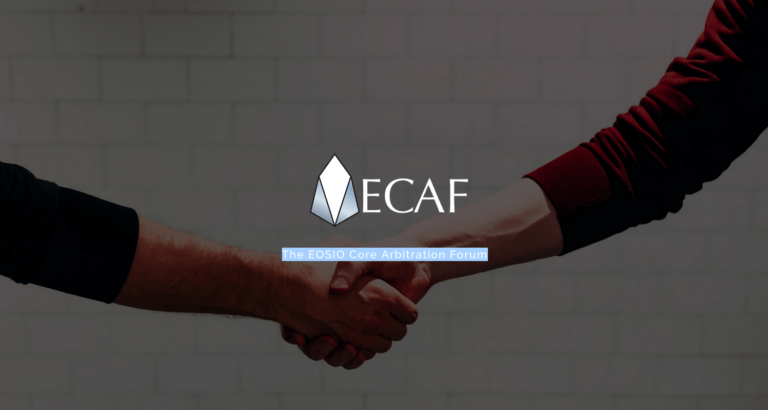This guide tries to answer frequently asked questions about the present and future of the EOS arbitration process. The answers are mostly based on information presented during a talk by Moti Tabulo, the interim head of the EOS Core Arbitration Forum (ECAF), at a London event on 4 July 2018 organized by “EOS London” (one of the world’s largest EOSIO meetup.com groups).
Q: Is there a special reason the acronym “ECAF” was chosen?
A: This acronym was partly chosen because when you write it in reverse, it reads “FACE” (they thought that this was appropriate since ECAF was supposed to be “the nice human face of EOS”).
Q: Why does EOS need arbitration?
A: Because problems may arise that need to get resolved, e.g. an issue between a Decentralized Application (DApp) and its users; or an issue between two DApps.
The basic problem is that you can’t draft a contract that covers every eventuality. Since humans can’t predict the future, every contract is in some ways incomplete. This is even more true when you are dealing with a new technology such as blockchain. This means that when people use a DApp, situations can arise that may be open to interpretation. And when you have different opinions, you can have disputes. So, sooner or later, disputes will occur. The question is how do we resolve these disputes?
In the real (off-blockchain) world, one way to resolve disputes is to go to our local courts. However, it is hard to do this when you are dealing with blockchain because (1) blockchain is operating in a global context; (2) many/most lawyers/judges don’t know anything about blockchain, consensus, DApps, etc.
Another way is arbitration. The advantage of arbitration is a single context across multiple jurisdictions. Arbitration reduces friction to doing business as it gives certainty (e.g. if you the developer of an DApp that has users in 50 countries, you don’t have to worry about dealing with the legal system of potentially every country in which you have users). Under the “New York Convention”, which is adhered to by more than 140 countries, national courts have to recognize and enfore foreign arbitral awards. This means that once an arbitration tribunal has made a ruling against you, you can’t then go to the courts and file a civil lawsuit in order to get a more favorable decision.
Q: How does EOS arbitration work?
A: EOS has the concept of a governed blockchain. There are three branches of government:
- Legislative (or Constituency) — token holders (they vote periodically on issues that are important for the whole community, e.g. the constitution, on critical features; voting is by referendum)
- Judicial — arbitrators (they resolve disputes, make special decisions, such as deciding if the constitution needs to be amended)
- Executive — block producers (they execute the code, produce blocks, carry out judicial decisions)
In order to have an arbitration forum for EOS, first, you need to have a basis for its existence (in ECAF’s case, it is by virtue of it being part of the EOS constitution) and also it needs to have a rule set for how it resolves disputes.
So, who runs ECAF? These are the arbitrators (they rule on disputes in their own names); case managers (they assist the arbitrators, e.g. they may review case, filter cases); and support functions (tech experts, lawyers, administrators).
To get ECAF up and running before the mainet launch was hard because we could not have a referendum when there was no EOS mainnet.
To bootstrap this process, an interim arbitration forum was created prior to the mainnet launch. This follows a default constitution. It has the basic rules in place. It has a set of named interim arbitrators. The idea is that once a fully tested referendum contract becomes available, there will be a referedum, i.e. a vote by token holders to either ratify the interim ECAF or the community could propose a different forum.
Although we currently have an interim ECAF, DApp developers can always name their own arbitration forum in their contracts.
Q: How do we know that the arbitrators will act in an honest manner?
A: If the community discovers that an arbitrator is not doing his/her job properly, it is possible to get rid of that person. A member of the community can allege that an arbitrator is corrupt by filing a case with ECAF. Then, a review panel of three arbitrators would be appointed. This panel would look through the evidence that has been put forward against a particular arbitrator. If the panel decides that the arbitrator has behaved inappropriately, he/she can be removed by the panel from the forum. If this happens, then the cases that this arbitrator has decided in the past may be opened up and re-examined.
Q: What is the current status of ECAF?
A: An interim ECAF exists. Arbitrators have been named and they are undergoing some training. This interim ECAF has started hearing cases. It is also trying to improve its processes.
Currently, since the original EOS constitution has not been ratified, we don’t have a ratified arbitration service. This means that although the interim ECAF can issue advice (advisory orders) to Block Producers (BPs), it cannot issue official orders that are binding on the BPs, which forces BPs (as the only elected representatives in the network) to get together to decide whether or not to follow such advice.
This means that it is very urgent for the community to vote in a referendum that chooses some kind of constitution in order to bring some clarity to this area.
Regarding the emergency action by the block producers on 17 June 2018, as previously explained by EOS New York, here is why the unanimous decision by the top 21 BPS to freeze seven EOS accounts (“to prevent victims of private key theft from having their tokens lost once the 72 hour unstaking period ended following the EOS Mainnet Launch) took place. EOS New York, while on a call with BPs and Block Producer Candidates (BPCs), “requested an expedited review of the merits of the case from ECAF… who was also on the call with the idea being that “if ECAF found merit in the evidence provided, a formal ruling from ECAF would ask the BPs to “freeze” the accounts in question until such time that a thorough and formal review of the claims could be completed.” Since ECAF responded “with the stance that they did not have the authority to act during this gray period wherein only an interim Constitution existed,” BPS found themselves “thrust into a position of acting as both executive and judiciary.” So the BPs were forced into a situation where they had to proceed as a group to review the evidence themselves, and they came to the difficult decision “of executing based upon the evidence brought forth.” EOS New York then sent a written request to ECAF asking for a formal statement (by no later than 1300 UTC 19 June 2018) regarding the validity of the freezing of those seven EOS accounts. on 19 June 2018, ECAF issued an order requesting the freeze to continue.
Q: What is next for ECAF?
A: The current constitution names ECAF as the default arbitration forum. There has been a new EOS constitution proposed by Daniel Larimer (architect of EOS) that has the idea of multiple parallel arbitration forums and no default arbitration forum.
Also, in the current constitution, we have the concept of “the code is law”. Larimer’s proposed constitution has the idea of “intent of code is law”. It is up to the token holders, when there is a referendum, to choose which constitution they prefer. Or they might some other constitution that gets proposed before the referendum takes place.
Whatever happens with the referendum on the constitution, ECAF can still continue offering arbitration services. ECAF intends to
- improve communication with the BPs and the community;
- recruit additional arbitrators and case managers; and
- improve its software infrastructure.









